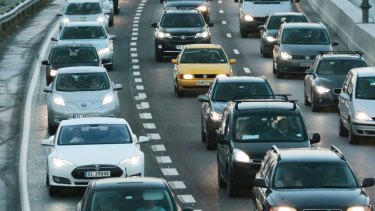
Loading
The carrots are many, and can involve subsidies for buying electric vehicles, tax and registration discounts, free tollway use, access to transit lanes and free parking. Sticks include increasingly stricter vehicle-emission standards, restrictions on vehicles with internal combustion engines in city centres, and setting dates for future outright bans on new ICE vehicle sales.
Policy can include vehicle-fleet purchase policy to acquire electric vehicles wherever possible (which increases both the future second-hand supply and electric vehicle choice by encouraging manufacturers to import them), replace public diesel bus fleets with electric vehicles, install public charging stations, reduce red-tape to make the installation of electric vehicle charging by private providers easier, and mandating housing standards to include provision for electric vehicle charging capacity.

Electric cars queue in the bus lane, left, on the main road into Oslo, Norway. In Norway some 30 per cent of all new cars sport plug-in cables. The country plans to have higher taxes on traditional cars.Credit:AP
Throughout the world, working examples of what governments can do to manage the uptake of electric vehicles are readily available. The report by independent Tim Storer’s Senate committee is also out there providing an Australian context for applying them here.
It is therefore not hard to do any of these things – if the will is there. New, stricter vehicle emission standards have been sitting on a government desk gathering dust for several years now. The line in the one-page press release on – "mandating an electric vehicle plug type" – is all but redundant now with combined charging system CCS2 becoming the default standard already adopted by almost all electric vehicles imported to this country.
Electric vehicles are already here. The transition is inevitable. We can either choose to manage it well for the benefit of all, or follow the current "do nothing" approach and let the problems of an unmanaged transition come to home to roost. We now await what the alternative government will have to say about electric vehicle adoption in its environment policy, which, according to its spokespeople, is expected "some time soon".
Bryce Gaton is an electric vehicle expert who has worked in the sector for 10 years and writes on its progress. He is secretary of the Victorian branch of the Australian Electric Vehicle Association.









 Add Category
Add Category